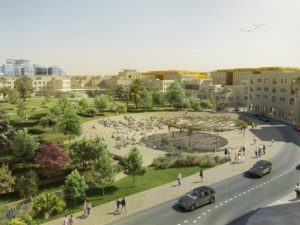The City of the Dead in Cairo isn’t known for its fertile soil, but Liveinslums is working to change that with an awesome mini urban farming initiative.
Although everybody seems to understand that population growth is exploding, and that space – particularly in cities – comes at a premium, the extent of our vulnerability to soil erosion is less understood. Liveinslums addresses all of these problems with one inspiring program being developed in several countries around the world – including Egypt.
Cairo’s City of the Dead is both a cemetery and slum area in the country’s most densely populated city. And it’s not the most fertile part of town either. A Non-Governmental Organization (NGO), Liveinslums has worked with local architects and designers to help residents here grow microjardins – mini, soilless, and transportable subsistence gardens that also fertilize the sand.
 In addition to being incredibly portable – a bonus for a population whose housing situation is less than stable – the microjardins are easy to put together.
In addition to being incredibly portable – a bonus for a population whose housing situation is less than stable – the microjardins are easy to put together.
According to Abitaire, in the first phase of their City of the Dead initiative, Liveinslums provided seeds, turf and perlite, which act as a substitute to soil, vitamin solutions that are added to water, and plastic, wood, and other recycled materials out of which the containers are made.
The residents get to choose what seeds they want to plant. Strawberries and tomatoes proved popular, with 500 each eventually bedded, as well as aubergines, peppers, and mint.
Although the microjardins are relatively adaptable, it is not possible to grow any vegetables that have long roots. Other than that, the sky is the limit, and there is an opportunity for participants to not only grow food for subsistence, but to make a little extra money on the side by selling what they grow.
While some farmers might stick to these mini, soilless plots, others have the option to transplant their food projects in burial yards or patios. Like the slow food movement and organic farm previously reported, urban farming initiatives have incredible power to transform lives and ease pressure on national agricultural challenges.
:: Abitaire
More on Urban Agriculture in the Middle East:
Egypt’s Urban Agriculture is Growing
What Rooftop Gardening Can do for the Middle East
Egypt to Get 3% of Africa’s Thousand Slowfood Gardens





Urban farms are possible because people revitalize the land and take care of it. Even in dense cities there is room for vegetables. The biggest obstacle is changing the way we conceptualize food and it’s origins.
Michael Kuenhert
Save The Farm Movie
http://www.cinemalibrestore.com/edu/save_the_farm.html
In the 11th hour and in the middle of south central L.A., they fought to save the farm.